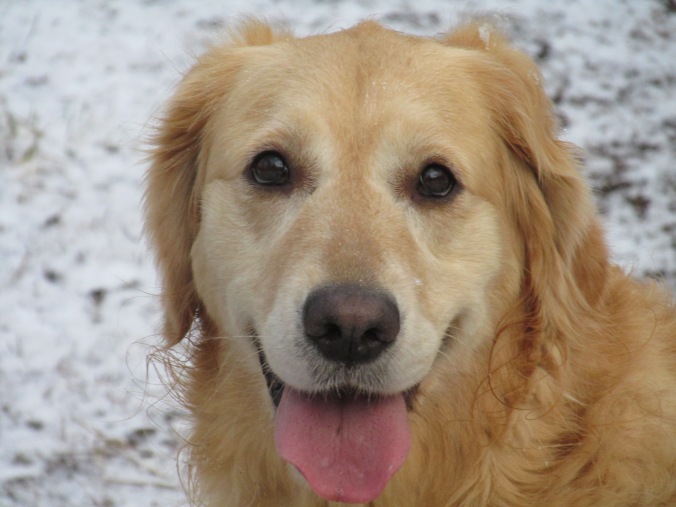National Eating Disorders Awareness Week 2013
We are currently in the midst of National Eating Disorder Awareness Week 2013 (Feb 24-March 2nd). The message NEDA (National Eating Disorders Association) is promoting is, “Everyone knows someone.” The unfortunate reality is that this holds true with far more prevalence than most people are aware; According to NEDA, “30 Million Americans will suffer from an eating disorder during their lifetime.” Don’t think you know someone with an eating disorder? If you know me, you do. I’ve lived with an eating disorder for the past ten years.
In honor of ‘NEDA Week 2013,” I’d like to dedicate this post to exploring the potential for assistance that service dogs may offer to those struggling with eating disorders.

A Brief Review of the Role of Service Dogs
Service dogs are dogs who receive individual training to do work or perform tasks which mitigate their handlers’ unique disabilities. It’s safe to say that, in most cases, the exact nature of the assistance a service dog offers is distinct from the manner in which a service dog assists another individual with the same or a similar disability.
In defining the role of a service dog, it’s also necessary to understand what is meant by the term, “disability.” A disability is a condition that affects an individual in a manner that significantly affects or limits one or more major life activity.
A service dog is *not* a dog whose sole purpose is to provide comfort through companionship, whether that means a person is less depressed because of the therapeutic benefit of having a pet dog or a person feels safer having a pet dog whose presence may serve as a potential crime deterrent.
Two factors must be simultaneously present for a dog to be considered a service dog: A person with a life-limiting disability and a dog who has been individually trained to mitigate the manifestation of that person’s disability.
Alternative Uses of Dogs to Benefit Those with Psychiatric Disorders
There are two additional roles dogs may play in the lives of people with medical conditions or psychiatric disorders. These additional roles, Therapy Dogs and Emotional Support Animals (ESA’s) are often confused with service dogs but it’s crucial to understand the differences between the roles. Later on, I will reference potential uses of ESA’s to benefit those who live with eating disorders. If you’d like to learn more about the differences between service dogs, therapy dogs and emotional support animals, visit the page on the subject at the Please Don’t Pet Me website.
An emotional support animal does not need to be a dog- although dogs will be the focus of this post. Emotional support animals, unlike service dogs, do not need to undergo any individualized training to mitigate their owners’ disabilities. The primary role of an emotional support animal is to provide a therapeutic benefit through companionship and the inherent comfort of having a dog around. They are permitted to live in housing that prohibits pets, as a reasonable accommodation to a person with a disability and may travel in cabin with their owners during air travel, per the discretion of their owners’ medical and mental health care providers. People with disabilities do not have the right, under the Americans with Disabilities Act, to be accompanied by ESAs in places of public accommodation, as they do with service dogs.
Physical Health Implications of Eating Disorders
Eating disorders are psychiatric in nature and have tremendous ramifications to sufferer’s physical health. Detrimental consequences are both short term and long term. Each type of eating disorder affects individuals differently but any eating disorder can carry a risk of mortality; this can be the result of heart failure caused by electrolyte imbalance or low blood pressure, kidney failure, caused by dehydration and esophageal rupture. Other negative health implications associated with eating disorders pose a threat of serious and lasting harm to those affected.
Comorbidity of additional psychiatric disorders among those diagnosed with eating disorders is prevalent, with some of the most common comorbid conditions including: Depression, Bipolar Disorder and Anxiety Disorders, like Obsessive Compulsive Disorder.
Linking Effects with the Benefits of Assistance from a Service Dog
It is not uncommon for service dogs to have ‘job descriptions’ that involve behaviors that can be the difference between life and death for their handlers on a regular basis. While not every individual who lives with an eating disorder is facing imminent risk of death on a day to day basis, the effects of some eating disorder behaviors can inch sufferers closer to a point at which that may change, as the eating disorder behavior becomes more extreme or cumulative effects of ongoing behaviors begin to affect the individual.
Independent of life-threatening or long term effects, some eating disorder behaviors can result in undesirable and unsafe short term effects, like fatigue, dizziness, headaches and syncope.
Keeping the degree to which they affect a person in mind, all of the aforementioned effects of behaviors associated with eating disorders have the potential to interfere with one or more major life activity, rendering an individual disabled. With the right forethought, it is certainly possible for an affected individual to benefit from the assistance of an individually trained service dog.
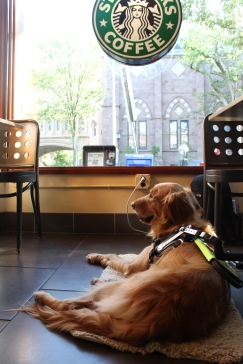
How Can Service Dogs Help Those with Eating Disorders?
Taking into consideration that the individual is affected by his or her eating disorder to a degree at which it meets the criteria to be considered a disabling condition, it’s important to remember that each disability manifests itself uniquely from one person to the next. Eating disorders are no exception. I’ll discuss just a few ways a dog can be individually trained to mitigate the disabling nature of various eating disorders. Most will be familiar to those who are familiar with the types of behaviors psychiatric service dogs assist people with various conditions and disorders that are not related to eating disorders.
- Preventing and Interrupting Maladaptive (Eating Disorder) Behaviors
With some creativity, there is virtually no limit to the manners in which a service dog can be trained to perform behaviors that are incompatible with something the handler struggles with resisting strong urges in which to engage. In regard to eating disorders, this can include anything from ritualistic eating (or exercise) habits to purging after eating. One example of how a service dog may prevent his handler from engaging in purging behavior may be to physically interrupt the individual’s efforts toward purging by doing something like persistent pawing at the handler or pawing at the door if the handler has shut the dog out of the room. The dog may also be trained to alert members of the handler’s family to the handler’s behavior by barking or using another trained cue to communicate with others who are actively supportive of the handler’s recovery. A service dog may also be trained to perform similar behaviors to interrupt a binge eating episode.
- Reminding the handler to perform important daily tasks
Service dogs can be trained to remind their handlers when it’s time for something important to happen. In the case of eating disorder behaviors, this may be something like a reminder to eat a meal or a snack. An effective way to condition a dog to remind the handler to do something at the same time every day is to create a daily routine that involves doing something the dog will look forward to and come to expect, each day at the same time. The service dog will need to be trained to perform a specific behavior that will serve as the reminder, in order to make the ‘payoff’ happen. The payoff can be something like a high value treat, a meal, a walk, a game of fetch- anything the dog loves. Ultimately, what will be most important is that the dog is persistent in his reminding behavior. It should be something that the handler cannot easily ignore.
- Medical Alert and/or Response
There are a wide variety of medical conditions for which service dogs can and often are trained to perform alerting and response behaviors for. Alerts are behaviors the dog performs before the onset of a medical crisis (or before the handler is aware of it), to warn the handler that it is coming. This gives the handler the opportunity to take appropriate action to either prevent the medical crisis or get into a safe situation in which to experience the oncoming crisis. Responses are behaviors that a service dog is trained to perform after a medical crisis has started to take place. A response can be anything from keeping the handler safe while the crisis takes place to alerting someone else that the handler is in need of assistance. Because some individuals with eating disorders experience effects like syncope (fainting), a service dog who is trained to detect a syncope episode and alert the handler to it can be tremendously helpful. If the dog isn’t capable of detecting it before it occurs, and many are not, the dog can be trained to respond by doing something like seeking out another person for help.
- Providing Trained Support During Times of Distress
This type of assistance is typical of most service dogs who are trained to assist people with psychiatric disabilities. The types of tasks service dogs may perform to be of such assistance vary significantly from one team to another. Some handlers can benefit from a service dog providing Deep Pressure Therapy, when anxiety levels rise. In the case of an eating disorder, it’s not at all uncommon for heightened anxiety to be a major factor in the individual’s experiences. This can be of particular prominence directly before, during and immediately after meals. Service dogs can be trained to perform any combination of behaviors to alleviate their handlers’ distress.
Of paramount importance to stress is that, similar to any other use of a service dog, this assistance is never to replace or conflict with effective medical treatment. The role of a service dog in the life of an individual with an eating disorder must be one that promotes steps toward the individual’s recovery- not providing assistance in a manner that supports the destructive nature of life with eating disorder behaviors. This unique partnership should allow the handler to build mastery in effective coping behaviors and ongoing progress, on the road to recovery.
Techniques for Using Pet Dogs or Emotional Support Animals to Manage Eating Disorder Behaviors
-Use training sessions to treat yourself along with your dog: Set up your training environment so you can enjoy a snack while rewarding your dog for his work. Each time your dog earns a reward to reinforce a behavior, treat your dog and be sure to take a bite of your chosen snack immediately after. (Make sure that you are not touching food or treats intended for dogs with the same hand you’re handling your own food with, to avoid contamination. Using eating utensils for your own food is recommended.)
– Eat with your dog: Schedule meals like breakfast and dinner at the same time you feed your dog.

– Walk away from purging: Plan the longer walks of the day with your dog for times after you eat. Not only will you be physically distancing yourself from your typical purging environment, but you will also be putting space between the time you consume your meal and the window of time you are most likely to purge. Any anxiety about purging is likely to subside, the longer you’re out on the walk. Make sure to make it a restorative, peaceful bonding experience for you and your dog.
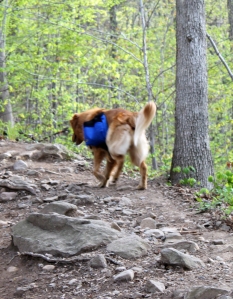 – Incorporate your dog’s exercise into your own exercise routine: Keeping your dog’s physical welfare in mind, most young, healthy dogs will happily become your outdoor workout buddy! Just as people need to train before they can become regular joggers or runners, dogs require conditioning, too. Make sure not to push your dog too hard, too fast. Once your dog is walking, hiking, jogging, biking, swimming or participating in other recreational activities with you, you can develop a balanced routine that keeps your dog’s happiness and safety in the forefront of your mind, while establishing healthy habits for yourself. (If it’s enough exercise for your active dog, it’s certainly adequate activity for most people.)
– Incorporate your dog’s exercise into your own exercise routine: Keeping your dog’s physical welfare in mind, most young, healthy dogs will happily become your outdoor workout buddy! Just as people need to train before they can become regular joggers or runners, dogs require conditioning, too. Make sure not to push your dog too hard, too fast. Once your dog is walking, hiking, jogging, biking, swimming or participating in other recreational activities with you, you can develop a balanced routine that keeps your dog’s happiness and safety in the forefront of your mind, while establishing healthy habits for yourself. (If it’s enough exercise for your active dog, it’s certainly adequate activity for most people.)
– Learn about nutrition: There’s a wealth of information available online about canine nutrition. Admittedly, some sources of information conflict with others, but there is a lot to learn. You’ll be putting yourself in a position to learn more about how to optimally fuel your dog’s body to provide him with the opportunity to be in prime health. Armed with your newfound knowledge and understanding of nourishing your dog, do yourself the same favor. Meet with a nutritionist and do your own research about what makes your body tick. Knowledge is power.

– Treat yourself as compassionately as you treat your dog: You would not want your dog to be without what he needs to be healthy and happy and he certainly wants you to show the same care to yourself. Balance is healthy for both of you and neither of you will judge the other for your imperfections.
Take Note
In the presence of any disability, the decision to use a service dog as a means of mitigating the manner in which an individual is affected is a very personal one. While the assistance a service dog can provide is invaluable, embarking on such a partnership is a tremendous commitment and responsibility. The commitment and responsibility is not only to the service dog who will be one’s partner for upwards of a decade, in some cases, but also a commitment to take care of oneself by doing whatever an individual and his or her medical treatment providers deem appropriate to best manage the symptoms of the medical condition. A service dog is neither a cure nor a band aid, but rather a partner with unwavering dedication to performing the job for which he was trained.
It’s important to emphasize that a diagnosis is not synonymous with a disability. While two people may receive the same diagnosis, that doesn’t mean they are both affected by the criteria an individual must meet to receive such a diagnosis in the same manner. The manifestation of a diagnosis for one person may be significantly life-limiting, while the other is able to manage symptoms and care for himself or herself independently. This is not exclusive to eating disorders; it is applicable to any medical condition, whether it is psychiatric, neurological or physical in nature. (On the other hand, one need not receive an official diagnosis to be affected by symptoms to a degree which renders the person disabled.)
Finally, upon researching the manner in which one may benefit from the assistance of a service dog, it will become clear that not all forms of service dog jobs are created equally under the law. Some tasks or work mitigate a disability to such an extent that a court of law would support the use of a service dog to perform individual tasks or work independent of additional trained tasks or work, while other trained behaviors may be helpful in allowing an individual to maintain safety and independence, yet they may not play a role significant enough for a dog to legally be considered a service dog.
Some of the concepts suggested above may not be strong enough ‘stand-alone’ tasks, yet a dog who is trained to perform a combination of them will make a greater impact on the disabled person’s independence. I recommend reading some task lists, particularly those outlined for psychiatric service dogs, on IAADP’s (International Association of Assistance Dog Partners) website, to learn more about ‘strong’ and ‘weak’ tasks or behaviors, when considering whether such skills would result in a dog being considered a service dog.
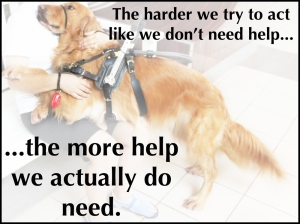
Comorbidity Of Psychiatric Conditions with Eating Disorders
As I mentioned above, there is a high occurrence of comorbidity of additional psychiatric conditions, among patients with eating disorders. Each of the most commonly occurring comorbid conditions (Major Depressive Disorder, Bipolar Disorder and Anxiety Disorders) has the potential affect an individual to such a degree that he or she may be disabled. Combining the effects of such conditions with those of eating disorders can have devastating consequences on the lives of those who are affected by them. The assistance provided by psychiatric service dogs could prove to be invaluable and life-changing, in such cases.
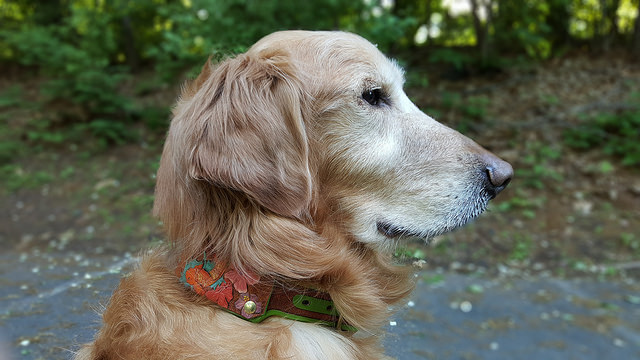

 Golden Retriever
Golden Retriever German Shepherd Dog (European Working Lines)
German Shepherd Dog (European Working Lines) Belgian Malinois
Belgian Malinois Doberman Pinscher
Doberman Pinscher Siberian Husky
Siberian Husky
